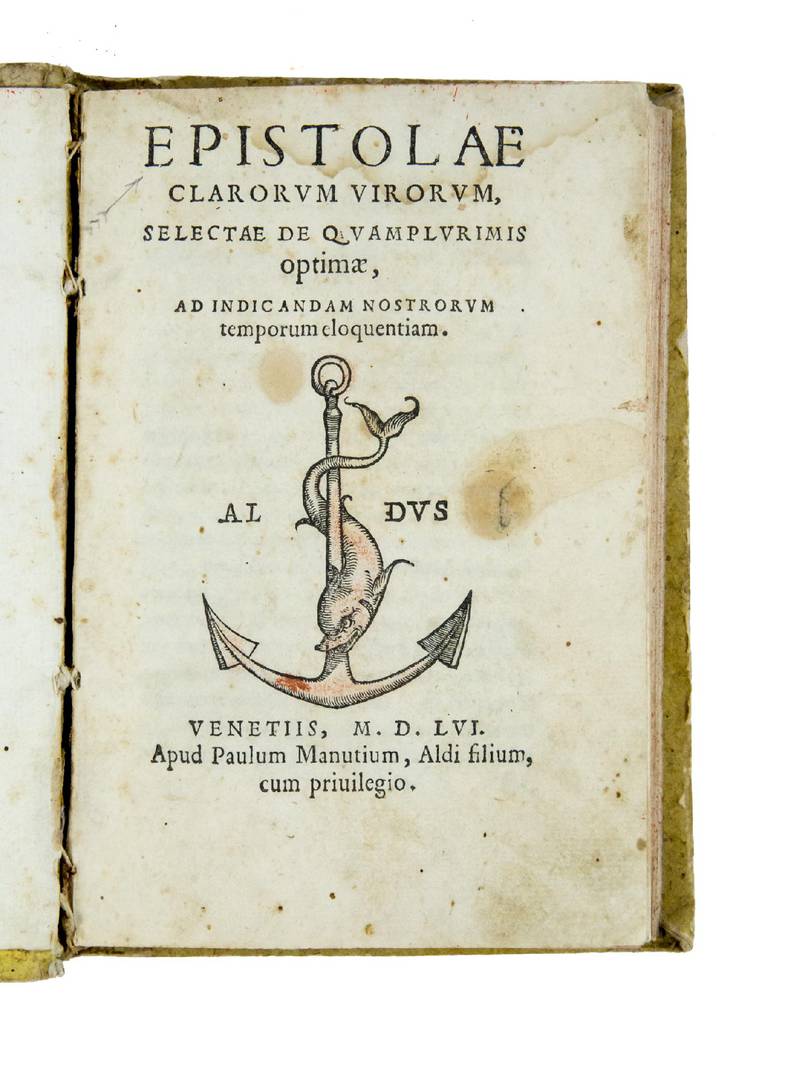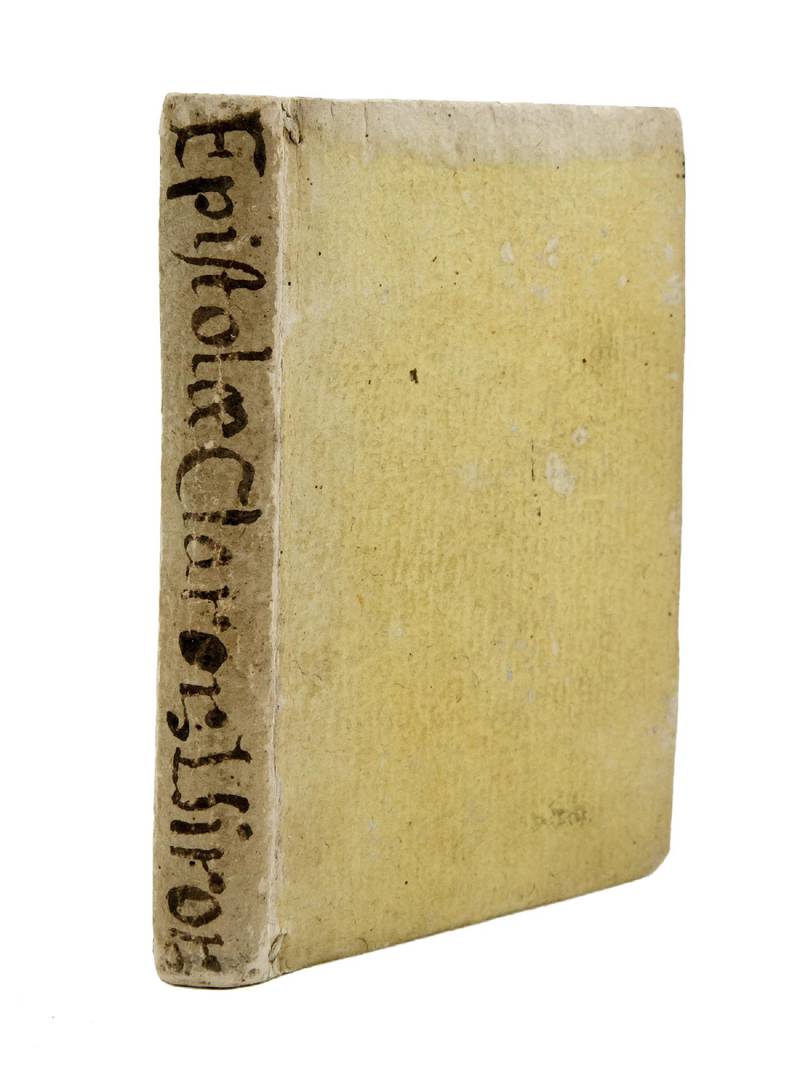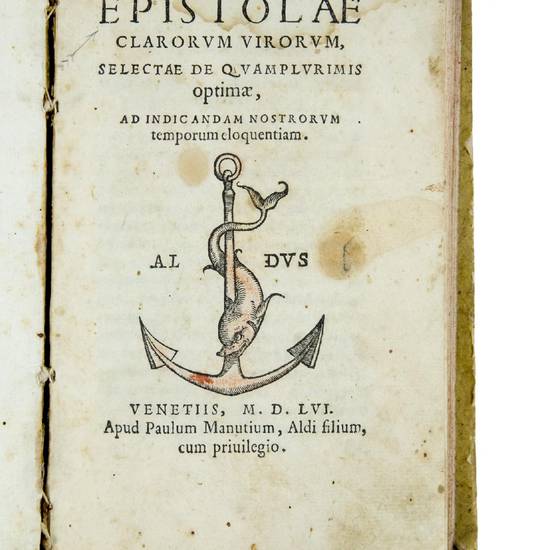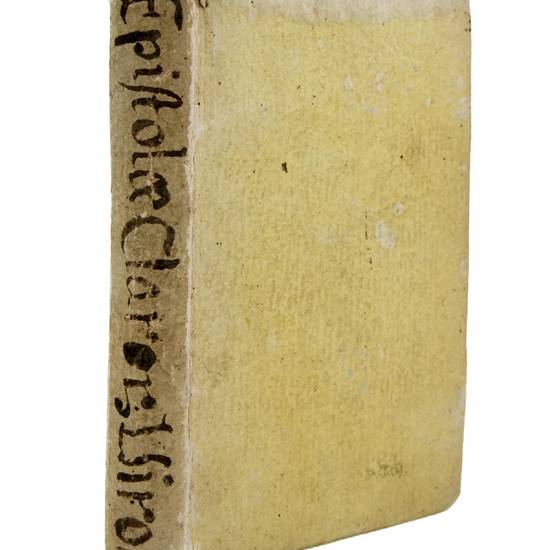8vo. 129, (3) leaves. A-Q8, R4. Printer's device on the title-page and at the end. Old boards, manuscript title on the spine, marbled edges, entry of ownership of Thomas Adami.
Adams, E-275; Edit 16, CNCE 18171; Renouard, p. 169, no. 13; G. Gueudet, L'art de la lettre humaniste, (Paris, 2004), p. 279; Th.F. Mayer, ed., The correspondence of Reginald Pole, (Aldershot, 2002-2004), ad vocem; E. Pastorello, L'epistolario manuziano, (Firenze, 1957), no. 158.
FIRST EDITION, reprinted in the same year at Paris by Bernardo Torresano, of this collection not to be confused with that of the same title issued by Giovanni Michele Bruto at Lyons in 1561. A new augmented edition appeared at Venice in 1568 (Guerra), which was reprinted again at Cologne in 1586 and 1587 (Gymnicus).
Paolo Manuzio issued this collection of Latin letters by different authors as a model book conceived to restrain the advance of the vernacular and the ‘ruina dell'eloquenza romana'. Paolo Manuzio, who in 1558 will publish his own extensive Latin epistolary (see item no. XXX), was considered by his contemporaries not only as an important editor, but also as a great humanist whose Latin prose was praised and appreciated all over Europe.
“Die von Paolo Manuzio 1556 herausgegeben Epistolae clarorum virorum, selectae de quamplurimis optimae ad indicandam nostrorum temporum eloquentiam bestätigen, als lateinische Mustersammlung zeitgenössischer Briefprosa, die ciceronianische Projektion des 1547 verstorbenen Kardinals [Pietro Bembo]. Einige Verfasser der hier ausgewählten 79 [recte 81] Briefe galten überdies als Verfechter des monolinguistischen Paradigmas, wie etwa Lazzaro Bonamico, Inhaber des Paduaner Lehrstuhls für die ‘Studia humanitatis' ab 1530, dessen Briefwechsel die Sammlung mit 16 [recte 19] Schreiben einleitet. Paolo Manuzio selbst hatte 1542 im Vorwort zum ersten Band der Lettere volgari di diversi nobilissimi huomini… seine durchaus gegenläufige Auffassung von der Überlegenheit des Lateins gegenüber dem Volgare auch im brieflichen Austausch unterstrichen […]“ (Worstbrock, F.J., ed., Der Brief im Zeitalter der Renaissance, Weinheim, 1983, p. 152).
The volume contains 81 almost always dated letters. The dates range between 1519 and 1552, but the great majority of them goes back to the Thirties and Forties of the century. The authors incorporated are prelates, humanists, and teachers of rhetoric and eloquence, preeminent for their mastery of Latin. Among them, the most represented are Lazzaro Bonamico (15 letters), Jacopo Sadoleto (9), Cosimo Gheri (9), Pietro Bembo (5), Giovita Rapicio (5), Reginald Pole (4), Pierre Bunel (4), Antonio Tilesio (4), and Benedetto Ramberti (2). Manuzio himself is present as the recipient of 3 letters.
Bonamico, Lazzaro to Savorgnan, Mario and Ramberti, Benedetto. Venezia (l. 2r)
id. to id. Padova, September 16 (l. 3r)
id. to [Tomicki], Piotr and Hosius, [Stanislaus]. Venezia, 1535 (l. 4r)
id. to Sadoleto, Jacopo. Padova, May 21, 1532 (l. 5r)
id. to Manuzio, Paolo. Padova, October 29, 1531 (l. 5v)
id. to Savorgnan, Mario. Padova, August 4, 1534 (l. 6v)
id. to Contarini, Gasparo. Padova, May 25, 1535 (l. 8v)
id. to [Doria, Andrea], Prince of Melfi. Padova, July 13, 1534 (l. 9r)
id. to Sadoleto, Jacopo. Padova, July 15, 1534 (l. 11r)
id. to id. Padova, December 30, 1536 (l. 12r)
id. to Pole, Reginald. Padova, December 30, 1536 (l. 13r)
Pole Reginald to Bonamico, Lazzaro. Roma, January 29, [1537] (l. 14r)
Bonamico, Lazzaro to Sadoleto, Jacopo. Padova, April 20, 1538 (l. 15r)
id. to Turiziano, Giovanni. Padova, November 24, 1533 (l. 15v)
id. to ‘instauratoribus Patavini gymnasij' (founders of Padua's Gymnasium). Padova, November 7, 1538 (l. 16v)
id. to Farnese, Ranuccio. Padova, April 8, 1543 (l. 20)
Pole, Reginald to Sadoleto, Jacopo. Padova, September 17, 1534 (l. 20v)
id. to id. Venezia, November 1, [1532] (l. 29r)
Sadoleto, Jacopo to Bonamico, Lazzaro. Carpentras, March 10, 1532 (l. 25, i.e. 33v)
id. to id. Carpentras, May 10, 1532 (l. 34v)
id. to id. Carpentras, September 3, 1532 (l. 27, i.e. 35v)
id. to id. (l. 36v)
id. to Pole, Reginald. Carpentras, November 23, 1534 (l. 38r)
id. to Bonamico, Lazzaro. Carpentras, November 23, 1534 (l. 41v)
id. to Pole, Reginald. Carpentras, December 3, [1532] (l. 43v)
id. to Bembo, Pietro. Roma, January 1, [1537] (l. 47r)
Bembo, Pietro to Fedeli, Giovanni Battista. Padova, January 22, 1532 (l. 47v)
id. to Gheri, Cosimo. [Padova, January 26, 1533] (l. 49r)
id. to Nigro, Girolamo. Venezia, January 11, 1531 (l. 49v)
id. to Paul III. Padova, October 19, 1534 (l. 50v)
id. to Sadoleto, Jacopo. Padova, January 4, 1537 (l. 52r)
Accolti, Benedetto to Paul III. Venezia, January 12, 1542 (l. 53r)
Sadoleto, Jacopo to [Accolti, Benedetto], Cardinal of Ravenna. Carpentras, August 1, 1541 (l. 54r)
[Accolti, Benedetto], Cardinal of Ravenna to Sadoleto, Jacopo. Venezia, September 17, 1541 (l. 56r)
Accolti, Benedetto to Paul III. Firenze, November 15, 1544 (l. 56v)
Ramberti, Benedetto to Gheri, Filippo. Venezia, October 7, 1537 (l. 58r)
id. to Manuzio, Paolo. ‘Ex Rosario meo', September 29, 1544 (l. 59v)
Bandinelli, Ubldino to Bembo, Pietro. Roma, February 16, 1537 (l. 61r)
Gheri, Cosimo, Bishop of Fano, to Contarini, Gasparo. (l. 65r)
id. to [Carafa, Giovanni Pietro], called Cardinal Teatino. (l. 66v)
id. to Carnesecchi, Pietro. (l. 67v)
id. to Giberti, [Gian Matteo]. (l. 69r)
id. to Maffei, Bernardino. (l. 69, i.e. 70r)
Villanovano, Simone to Savorgnan, Girolamo. Padova, November 22 (l. 71r)
Danesi, Pietro to Colini, Jacopo. March 28, 1534 (l. 73v)
Rapicio, Govita to the Magistrates and Citizens of Brescia. Venezia, May 4, 1538 (l. 76v)
id. to Ramusio, Giovanni Battista. Brescia, August 25, 1544 (l. 77v)
id. to the Magistrates and Citizens of Brescia. Venezia, June 1, 1538 (l. 78r)
id. to Ramusio, Paolo. Venezia, August 1, 1547 (l. 79r)
id. to Monti, Girolamo. Venezia, September 1 , 1548 (l. 80r)
Orechovius (Orzechowski), Stanislaus to Ramusio, Paolo. Przemyl, August 15, 1549 (l. 81r)
Pole, Reginald to Ramusio, Paolo. [Bruxelles, May 26, 1554] (l. 84r)
Bunel, Pierre to Magetano, Giuseppe. Venezia, [November 13, 1531] (l. 84v)
id. to Corner, Andrea. Venezia, [October 31, 1531] (l. 87r)
id. to ‘Carolo *'. Venezia (l. 88v)
id. to Manuzio, Paolo. Padova, November 19, 1533 (l. 90r)
Fausto, Vittore to Bezichem, Marino. Venezia, April 28, 1519 (l. 90, i.e. 91v)
id. to Ramusio, Giovanni Battista. Veenzia, September 13, 1530 (l. 91, i.e. 92r)
Sadoleto, Paolo to Bonamico, Lazzaro. Carpentras, November 24, 1534 (l. 94, i.e. 95r)
Maffei, Bernardino to Castelvetro, Ludovico. (l. 96v)
Egnazio, Giovanni Battista to Avvocaro, Matteo. Venezia, November 25 (l. 97v)
id. to Amaseo, Romolo. Venezia, January 1, 1530 (l. 101r)
Amaseo, Romolo to Egnazio, Giovanni Battista. Bologna, January 23, 1530 (l. 102r)
Selves, Georges de to Bembo, Pietro. Venezia, September 10, 1534 (l. 105r)
Gheri, Cosimo to Paul III. Padova, October 18, 1534 (l. 106r)
id. to Ramberti, Benedetto. Padova, June 21, 1536 (l. 107r)
id. to id. Padova, June 26, 1536 (l. 107v)
id. to id. Fano, November 26, 1536 (l. 108r)
Parrasio, Giano to Manuzio, Aldo. Vicenza (l. 109r)
Dracus, Nicolaus to Egnazio, Giovanni Battista. (l. 110r)
Tilesio, Antonio to Ramberti, Benedetto. Cosenza, February 12, 1530 (l. 111v)
id. to Franceschi, Andrea. Cosenza, September 19, 1530 (l. 105, i.e. 113r)
id. to Ramberti, Benedetto. Napoli, December 12, 1531 (l. 114r)
id. to id. Napoli, April 12, 1532 (l. 107, i.e. 115r)
Crasso, Giovanni Pietro to Valeresio, Federico. May 5, 1533 (l. 107, i.e. 115v)
id. to Contarini, Gasparo. Viterbo, May 23 (l. 118r)
n.s., n.r. Piove di Sacco, August 23, 1552 (l. 120r)
Fausto, Vittore to Navagero, Andrea. Venezia, June 1, 1527 (l. 123v)
n.s., n.r. Venezia, October 16, 1540 (l. 125v)
n.s., n.r. Venezia, December 29, 1546 (l. 127r)
n.s., n.r. Venezia, May 1, 1547 (l. 128v)
Paolo was the youngest son of Aldo Manuzio the Elder. He had the misfortune to lose his father at the age of two. After this event his grandfather and two uncles, the three Asolani, carried on the Aldine Press, while Paolo prosecuted his early studies at Venice. Excessive application hurt his health, which remained weak during the rest of his life. At the age of twenty-one he had acquired a solid reputation for scholarship and learning.
In 1533 Paolo undertook the conduct of his father's business, which has latterly been much neglected by his uncles. Paolo determined to restore the glories of the house, and in 1540 he separated from his uncles. The field of Greek literature having been well night exhausted, he devoted himself principally to the Latin classics. He was a passionate Ciceronian, and perhaps his chief contributions to scholarship are the corrected editions of Cicero's letters and orations, his own epistles in a Ciceronian style, and his Latin version of Demosthenes. Throughout his life he combined the occupations of a scholar and a printer, winning an even higher celebrity in the former field than his father had done. Four treatises from his pen on Roman antiquities deserve to be commemorated for their erudition no less than for the elegance of their Latinity.
Several Italian cities contended for the possession of so rare a man. He also received tempting offers from the Spanish court. Although his publications were highly esteemed, their sale was slow. Thus his life was a permanent struggle with pecuniary difficulties. In 1556 he received for a time external support from the Accademia Veneta, founded by Federico Badoer, who failed disgracefully in 1559, and the academy was extinct in 1562. Meanwhile Paolo had established his brother Antonio, a man of good parts but indifferent conduct, in a printing office and book shop at Bologna. Antonio died in 1559, having been a source of trouble and expense to Paolo during the last four years of his life. Other pecuniary embarrassment arose from a contract for supplying fish to Venice, into which Paolo had somewhat strangely entered with the government.
In 1561 Pius IV invited him to Rome, offering him a yearly stipend of 500 ducats, and undertaking to establish and maintain his press there. The profits were to be divided between Paolo Manuzio and the Apostolic Camera. Paolo accepted the invitation, and spent the larger portion of his life, under three papacies, with various fortunes in the city of Rome. The works published by the Stamperia del Popolo Romano were mostly Latin works of theology and Biblical or patristic literature. Meanwhile his eldest son, the younger Aldo, had succeeded him in the management of the Venetian printing house. Overtaxed with studies and commercial worries Paolo died at Rome in his sixty-second year (cf. T. Sterza, Paolo Manuzio editore a Venezia (1533-1561), in: “ACME. Annali della Facoltà di lettere e filosofia dell'Università degli studi di Milano”, 61/2, 2008, pp. 123-168; and F. Barberi, Paolo Manuzio e la stamperia del popolo romano (1561-1570): con documenti inediti, Roma, 1942, passim).
[9157]





